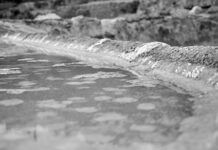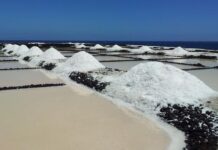
Kosher salt is one of the most commonly used varieties of edible salt in commercial kitchens today. Kosher salt has a much larger grain size than regular table salt, and a more open granular structure.Sea salt, obtained by evaporating seawater, is used in cooking and cosmetics. Historically called bay salt, its mineral content gives it a different taste than table salt.
Kosher salt gets its name not because it follows the guidelines for kosher foods as written in the Torah but because of its use in making meats kosher, by helping to extract the blood from the meat.
Comparison chart
| Produced by | Evaporation | Evaporation of salt water |
|---|---|---|
| Price | A 48 ounce box may cost around $2 | 79c per pound and up (A 26 ounce container costs around $3) |
| Uses | Cooking, curing meat | Cooking, cosmetics |
| Also called | Rock salt | Bay salt |
| Composed of | Sodium chloride | Sodium chloride and minerals |
| Grain size | Large | Large in pyramid shape |
Composition
Both consist of the chemical compound sodium chloride. Minerals like calcium and magnesium are added to Sea salt to give it a taste different than table and kosher salt. Kosher salt typically does not contain any additives though some companies may add some minerals to make it free flowing. Both have a 97.5% sodium chloride content.
Physical Texture
Kosher salt is characterized by its big crystals with large surface areas. The crystals in sea salt are not as big as kosher salt and are in pyramid shape. Kosher salt’s size and shape allows it to absorb more moisture than other forms of salt.
Production
Kosher salt is made by evaporation process. However, some processes allow their crystals to grow at normal atmospheric pressure which makes a different shaped and larger crystal possible. In other manufacturing processes, Kosher Salt is made by compressing table salt crystals under pressure and then sizing the resulting agglomerates to yield a coarse-type salt. Sea salt is produced by evaporation of sea water at atmospheric temperature and pressure. The crystals tend to form inverted pyramid shapes not all that different from Kosher Salt produced at atmospheric pressure referred to in the first paragraph. Depending upon the geographic location, altitude, and composition of the salt ponds from which the salt originates, the salt may take on certain colors representing some of the trace minerals in the area.
Use
Sea salt and kosher salt possess large, irregular grains that add a delightful crunch and hit of briny flavor when sprinkled on food at the last minute. Generally, savvy cooks prefer kosher salt when cooking, since its coarse texture is easier to take a pinch of when seasoning savory dishes. Kosher salt is used for curing meats and also for baking with recipes that use small amounts of liquid. Sea salt is also used in cosmetics.
Price
Generally sea salt is considerably more expensive than Kosher Salt. Current prices for these products can be found on Amazon.com:









![Effect of sea mud compresses from Messolonghi lagoon as a treatment for cellulite [Experimental study]](https://saltandmud.gr/wp-content/uploads/2021/08/unnamed-218x150.png)










